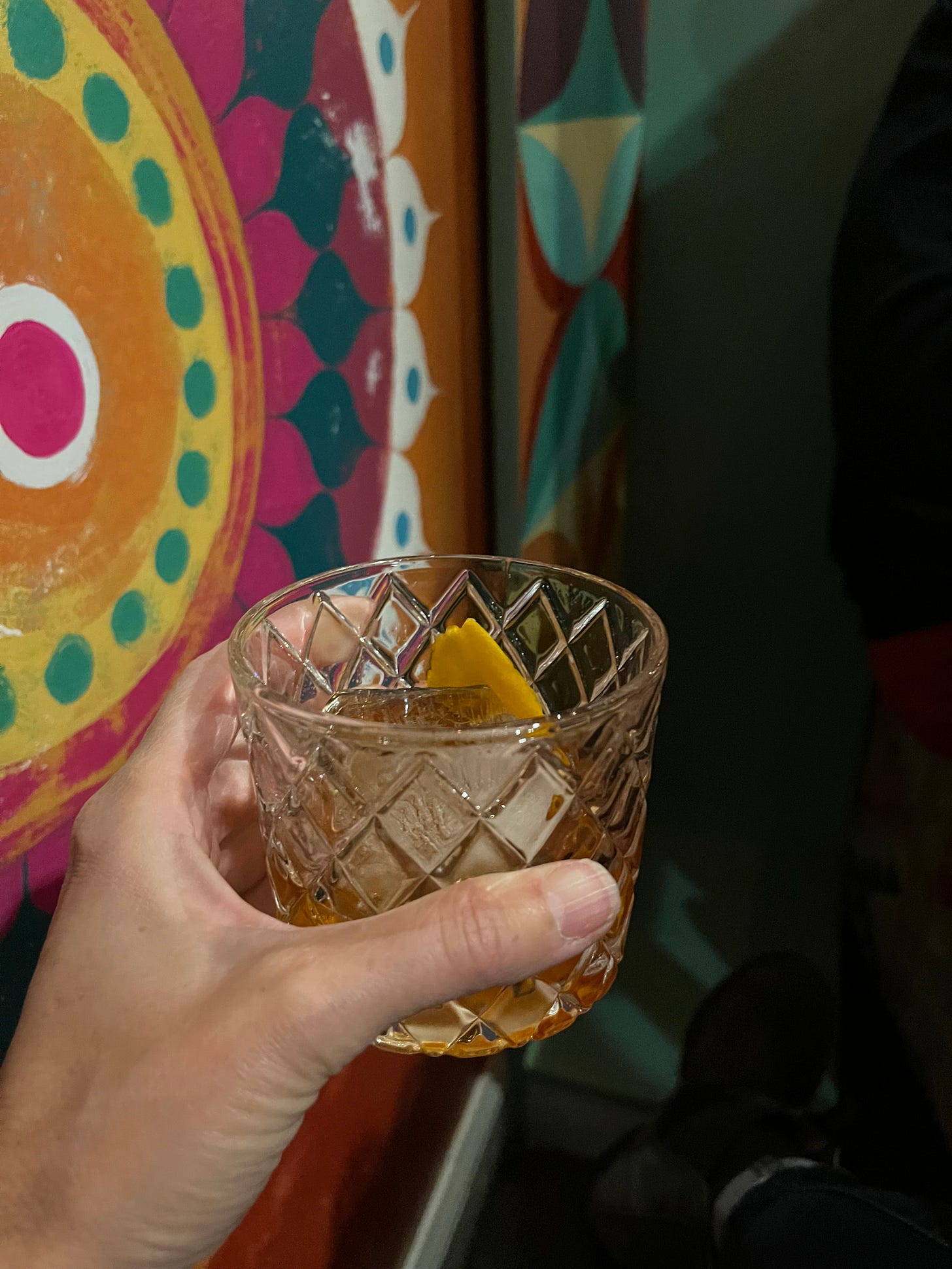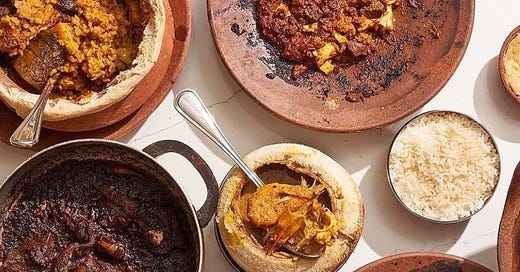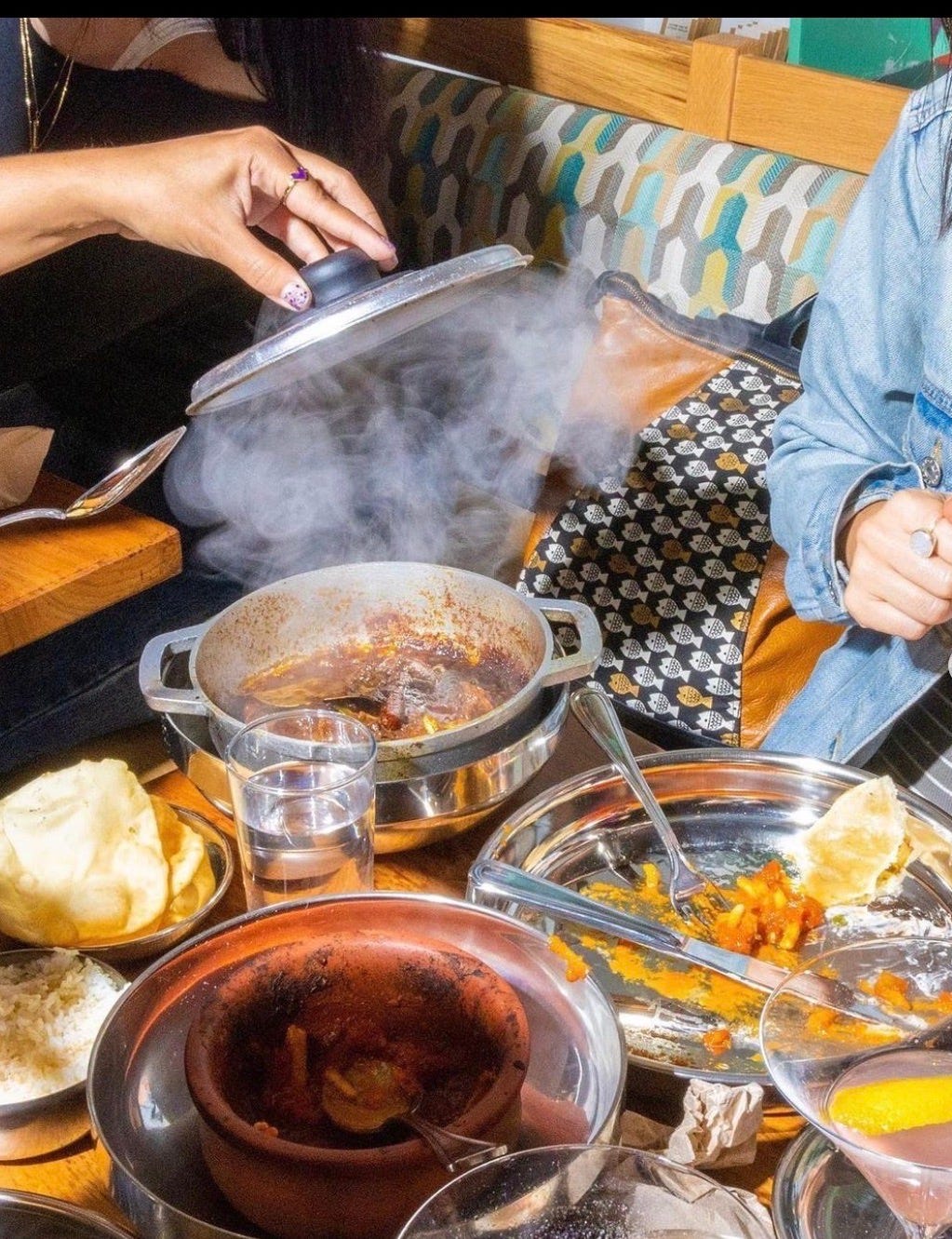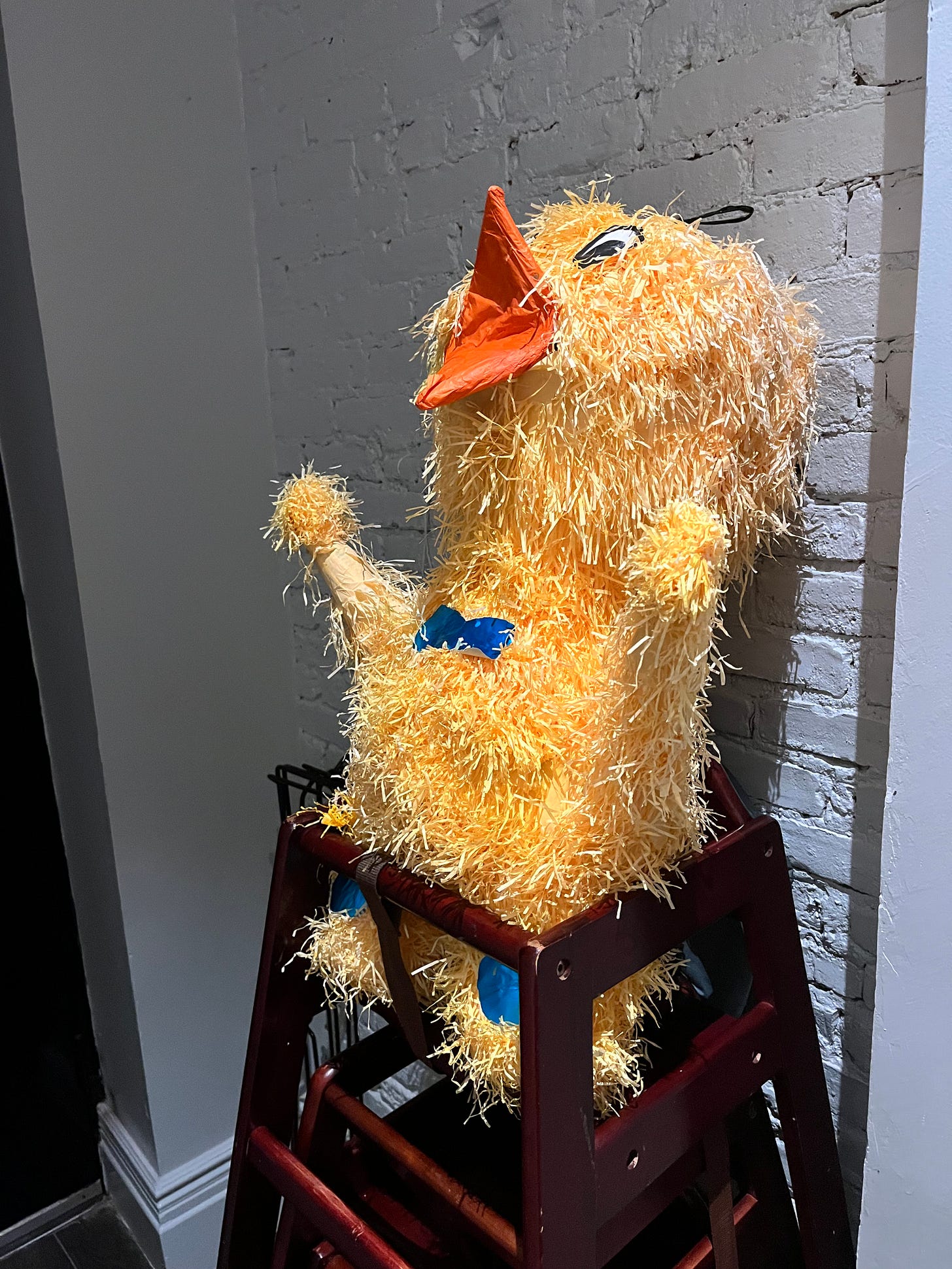Masalawala & Sons is everything you need right now.
The joy of home cooking, fiery with memory (and also, a chicken piñata).
It wasn’t too long ago that an older Indian gentleman came for dinner at Masalawala & Sons, the latest restaurant from restaurateur Roni Mazumdar and James Beard Award Winning Chef Chintan Pandya, the pair who also own the impossibly popular Dhamaka, Semma, Adda Indian Canteen, and Rowdy Rooster under the umbrella “Unapologetic Foods.”
The gentleman sat at the bar where he ordered a few plates of food. There were Sabudana Vada, flat fritters of tapioca pearls, peanuts, and spiced potatoes, with a yogurt chutney. There was Keema Kaleji, goat mince and liver, with black cardamom, cloves, soft egg, and big puffy rolls of pao. A pot of Morog Boti, a buttery bone-in chicken, braised with garam masala and red chilis, with a mint chutney.
The food arrived but the gentleman did not eat. Roni and Chintan were concerned. They approached him to see if everything was okay. “Never have I seen a meal like this so far from home,” the older gentleman told Roni. “To think that the food that I grew up with would be in a restaurant served by a Michelin star chef in New York City!”
“But you are not eating it, why?” they asked.
“Your food is bringing me back to my family, and I can’t eat it yet. I just want to sit here and remember.”
Masalawala does in fact feel like a memory; this is perhaps the best way to describe the experience of eating at this restaurant, which showcases the food of Roni’s father Satyen with intricate age-old techniques, and family recipes. It is food that tastes like home, even if you don’t come from Kolkata where Roni and his father grew up. (The “Sons” in the restaurants name refers both to Roni and Chintan, Satyen’s ‘adopted’ son.”
Come inside from the sidewalks of this rather random stretch of Park Slope’s Fifth Avenue—dive bars, bodegas, bagel and barber shops—and you will feel something come alive inside you. Maybe it’s a memory, perhaps it is a yearning; it’s a place inside of you making room for a feeling that wasn’t there before.
For me, the room on that cold rainy night reminded me of my Persian grandmother’s home, and the way the air would change while walking down the long hallway in her apartment building, from musty and stale, to humid and sweet, heavy with toasted spices and freshly chopped herbs – dill, turmeric, cumin, coriander – and the aroma of basmati rice steaming on the stove in a giant pot, snuggled under a dish towel and a tight fitting lid under my Bibi’s care. Food is one powerful hallucinogen; it takes you places. I do believe it is its own variety of MDMA; and Masalwala is serving it in very powerful doses.
Masalawala, which means Spice Merchant, feels like a celebration; all dressed up with pom pom garlands of sunshine yellow and orange marigold draped from the ceiling, with colorful murals in mesmerizing swirls painted on the walls, and an antique photo of the patriarch Satyen Mazumdar front and center. It has the fizzy unstoppable energy of a party, of an open air restaurant on a sunny day in the center of a bustling Indian Bazaar.

Much of the food at Masalawala arrives at the table in the vessels in which it is cooked. This is quite intentional; in Kolkata, the village cooks could not afford serving vessels, so they used what they cooked the food in — banana leaves, coconuts, small crockeries, and the like. The food at Masalawala may be humble, yes, but it is not meek. It is confident and bold, and also very spicy; chiles are used with gusto and abandon. My nose was running. I’d bring tissues. Be prepared.
Before you even have a drink (and the cocktails are gorgeous, so have a round), check to see if the chef has any orders of Macher Dim left. It’s often 86’d early, so get on this right away. It’s a marvelous little bowl filled up with rice cooked in a very special Gawa Ghee, a type of ghee made in the eastern part of India. It tastes as though the butter has been cooked down with toasted hazelnuts, so it’s warm and nutty, and it makes the Kalajeera rice a golden color, like it’s been steeped in turmeric. It’s ghee on botox. To the rice, the chef adds fish roe, egg yolk, and a lot of green chili. Then it all gets baked off in a neat little crock.
Sink in your little spoon and you’ll find it tastes nothing like fish roe, it’s not briny at all, and it’s not much like egg either. What you get is the sweetness of the nutty rice and the heat of the chili, and it’s magnificent. Now I know you are thinking, I don’t know, Andrea….you want me to get rice cooked in butter with fish roe and eggs? Yes, I do. You will thank me. Of all the dishes I ate at Masalawala, this was my favorite. I want to eat it forever.
Eggs, which are so pedestrian in America, are a sign of elegance in India. For instance, if you were to have the Ripon Street Majja — a dark and rich bone marrow braise smoldering with smoked chili, at home with your family, you’d just have it with some puffy pao (think golden Hawaiian rolls but puffier and less sweet). But at the restaurant the dish is served the way it would be prepared if guests were coming over; topped with the luxury of shaved egg, like one might use truffles. The marrow stew is served with warm toasted pao and small flat wooden spoons that reminded me of the ones you’d get in the tops of Marino Italian Ices. Use those spoons to scrape out the unctuous lobes of marrow and mix it in with the chile braise and egg, and dunk your pao. It’s sort of an Indian Sloppy Joe. Sort of.
Another celebratory dish on the menu is the Biye Barir Fish Fry, which apparently is an essential wedding dish. “If you don’t serve this fish fry at your marriage you are a cheap person!” Roni told me. Understood. So if you’d like to plan your nuptials at Masalawala next time you come in for dinner, go right ahead; the fish fry is on the menu ready for you and your beloved. And the room is so festive you’ll really have all you need for a proper party with the garlands and the fish fry.
The marital fish fry is made from a white fish called Bhekti, that’s sort of a cousin to Barramundi that gets marinated in cilantro and chilis, before it is battered in butter, and fried until puffy and dark brown. No chips with this fish though people, this is not England, it’s Kolkata.
You won’t find the traditional Indian breads on the menu here—no naan, or paratha, because these breads are not indigenous to the Bengal region. Rather you’ll find pao, and puffy ghee-glossed rounds of puri that come with the Kosha Mangsho—braised lamb, tender as the night, that arrives in a cast iron cooking pot full of fragrant chiles, ginger, coriander, and pods of green cardamom. Daab Chingri, a dish of head-on tiger prawns, is served in the large fresh coconut in which they are cooked. Tableside, the waiters spoon the prawns out of the young coconut, in a sauce rich with black caraway and chiles that makes those prawns highly desirable.
The restaurant serves two main course rice dishes; there’s a vegetarian Khichiri, made from kalajeera rice,with mung daal, farm vegetables, ghee (naturally), and garam masala, but we opted for the Macher Pulao, made from basmati rice with grains so long and slender they resemble Spanish Fideos, baked off with hunks of Magur, an Indian catfish tossed in a high heat chile-rich masala. I had the leftovers the next day for dinner while watching The White Lotus, Season 2, and felt like the luckiest woman alive.
For dessert, there is only one, and please have it. It’s called Bhapa Doi, and it looks like creme brulee but it’s actually thick Greek yogurt that’s cooked down with jaggery (like brown sugar) and egg yolk. It’s sweet, tangy, dense, creamy and impossible to resist. You could eat it all quite easily. I did.
After dinner, I walked to the back of the restaurant to use the bathroom, winding my way through tables of two, four and more, happiness crowded around metal plates, coconut carcasses, steamy clay pots and empty cocktail glasses. When I finally made it to the restroom, I found a giant yellow chicken piñata sitting in a stack of high chairs opposite. The chicken piñata had on a blue bowtie, and a look of hysterical glee on its face, as though it had just eaten at Masalawala for the first time.
On my way out of the restaurant, I asked Roni about the piñata chicken and he informed me that it was one of the waitresses birthday and they had brought in the piñata to have at the party after work. It would be removed from the high chair and strung up among the garlands, whacked open for a shower of Indian sweets. Amazing.
Masalawala & Sons is a place you will come to eat with abandon and passion, and possibly to whack a pinata chicken or have a marital fish fry. It is a place where you will pass many plates back and forth, where you will lick your fingers, and take one more bite, and one more bite, and oh just one more bite, until the bowls, plates, pots, and coconut carcasses are licked clean. You will leave and feel very full and very happy. And perhaps you will feel like you have found a home in a place you’ve never been before, but can’t wait to come back to.
Masalawala & Sons is located at 365 Fifth Avenue (between 5th and 6th Streets) in Brooklyn’s Park Slope.






